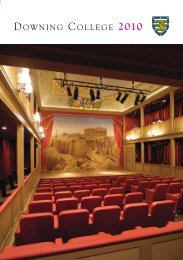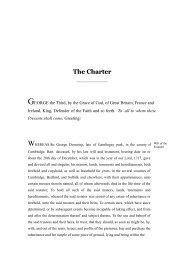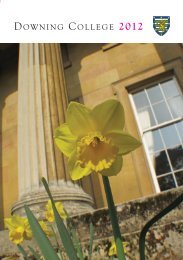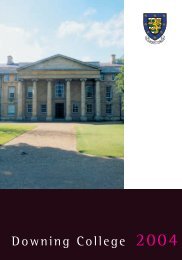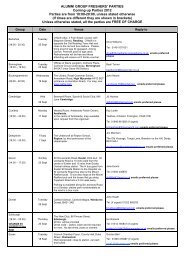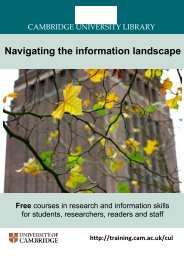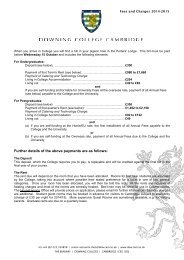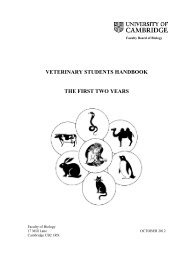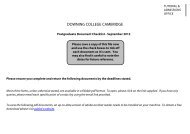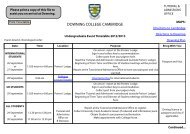ows <strong>of</strong> 10 pr<strong>of</strong>essors’ pavilions with 100 student room. The two wings were 120 feetapart and at the north or closed end he located the library, known as the Rotunda.The south end was left open for further expansion. Behind the two rows <strong>of</strong> studentrooms and pr<strong>of</strong>essors’ pavilions were gardens with curvilinear walls and then outerrows <strong>of</strong> more student rooms and hotels connected by arcades for eating. Acornerstone was laid for the <strong>University</strong> on 6 October 1817. The complex was builtbetween 1817 and 1825 when the first students entered. In the 1890s after a fire inthe Rotunda the south end was closed <strong>of</strong>f with a complex <strong>of</strong> buildings.The two campuses while having some similarities also contained majordifferences. <strong>Downing</strong> after 1821 until the 1950s was essentially two parallel rows <strong>of</strong>buildings while Virginia was a U shaped composition.Another issue is how did Jefferson know <strong>of</strong> Wilkins’ design? Jefferson lived inFrance between 1784 and 1789 and closely observed architecture. He visited Englandseveral times most notably during the spring <strong>of</strong> 1786. He visited Oxford (notCambridge) and viewed notable English gardens and a number <strong>of</strong> houses includingBlenheim and Chiswick, Wilkins’ design is <strong>of</strong> course much later, 1805–06. A few views<strong>of</strong> the completed Master’s Lodge were published in 1812 and 1814 but they shownothing <strong>of</strong> the projected scheme. Sometime later a view was published <strong>of</strong> the longsouth front with three porticos, and also one <strong>of</strong> the northern entrance, the portico,or propylae. While it is possible that somebody told Jefferson about Wilkins’ scheme,the question remains who? Jefferson was a noted correspondent who kept copies <strong>of</strong>all his letters, and along with those who wrote to him. There is no reference inJefferson’s vast correspondence to the <strong>Downing</strong> scheme, nor to Wilkins, and he neverowned the various books that illustrated it. It is possible he was told about it eitherorally, or in writing, but to date no evidence has been found.More important is that <strong>Downing</strong> <strong>College</strong> and the <strong>University</strong> <strong>of</strong> Virginia are bothproducts <strong>of</strong> a classical sensibility. Both Jefferson and Wilkins were classicists but <strong>of</strong>different types. They subscribed to the concept that architecture was bound by rulesand concepts that first emerged in Greece, were passed on and elaborated by theRomans, and then re-discovered in the 15th-18th century by architects such asAlberti, Palladio, Jones, Ware, and many others. Classicism meant to both individualsthat correct architecture was governed by the orders, proportion, and it should showsymmetry, balance, hierarchy, and wholeness. Wilkins was a significant re-interpreter<strong>of</strong> classicism with his books such as Antiquities <strong>of</strong> Magna Graecia (1806/<strong>07</strong>) The civilarchitecture <strong>of</strong> Vitruvius, (1812) and Athneiensia, or remains on the topoqraphy andbuildinqs <strong>of</strong> Athens (1816). He was a member <strong>of</strong> the Grecophile group and veryimportant in introducing the Greek Revival into England. Wilkins’ Greek interestmeant he rejected the five orders employed since the Renaissance for a more strictemployment <strong>of</strong> the three Greek orders. In a sense, Wilkins was avant-garde forhis day.73
74In contrast, Jefferson was a Palladian and by architectural standards in bothEngland and the United States in the years 1810 onward, old fashioned. He spurnedthe new interest in Greek architecture promoted years earlier by James Stuart andNicholas Revett’s Antiquities <strong>of</strong> Athens (1762), and never owned a copy <strong>of</strong> their book(nor any <strong>of</strong> Wilkins). Instead Jefferson preferred the much earlier book TheArchitecture <strong>of</strong> A. Palladio, (London, 1715, 1721, 1742), translated by Giacomo Leoni.He refused to use the more updated volume on Palladio by Isaac Ware and sponsoredby Lord Burlington, and instead used what was considered a “corrupted” edition,the Leoni.Central to Wilkins’ and Jefferson’s designs were some autobiographical elements.<strong>Downing</strong> reflects Wilkins’ recent studies in Sicily and Greece and also his Cambridgebackground. He knew well the Cambridge quadrangle scheme having been a studentat Gonville & Caius, and his original plan for <strong>Downing</strong> was a regularized, enlarged,and classicized Cambridge square. He had a gate, a chapel, a library, and rooms forthe master, fellows and students, similar to most other colleges. Jefferson’s designfor the <strong>University</strong> reflects his own collegiate background. He attended the <strong>College</strong><strong>of</strong> William & Mary in Williamsburg 1760–63. All the students-some 40 young menandthe faculty-mostly Anglican clergymen-lived in a single large building wherethey ate, slept, and took classes. Descriptions <strong>of</strong> life at William & Mary included ruttybehaviour and one <strong>of</strong> the clergymen liked to liquor up the students and lead themon “charges” against the town’s people. Another clergyman during Jefferson’s studentyears fathered an illegitimate child.In succeeding years Jefferson became a tireless advocate for public educationintroducing a bill in 1778 to the Virginia legislature for the state to assumeresponsibilities at the primary, secondary, and collegiate level. Also he argued thatcolleges should not be controlled by the church. Again while president he advocateda national university. But in both cases nothing happened.However his reputation as an education advocate led to solicitations for adviceand his response indicates his rejection <strong>of</strong> the <strong>College</strong> <strong>of</strong> William and Mary prototype<strong>of</strong> a single building. In 1805 to a request he wrote: “large houses are always ugly,inconvenient, exposed to the accident <strong>of</strong> fire, and bad in cases <strong>of</strong> infection. a plainsmall house for the school & lodging <strong>of</strong> each pr<strong>of</strong>essor is best. These connected bycovered ways out <strong>of</strong> which the rooms <strong>of</strong> the students should open would be best.These may then be built only as they shall be wanting. in fact an <strong>University</strong> shouldnot be an house but a village. this will much lessen their first expences [sic].” A fewyears later in 1810 to another inquiry he wrote that each pr<strong>of</strong>essor’s “small andseparate lodge” should contain “only a hall below for his class, and two chambersabove for himself; . – . the whole <strong>of</strong> these arranged around an open square <strong>of</strong> grassand trees would make it, what it should be in fact, an academical village, instead <strong>of</strong>a large & common den <strong>of</strong> noise, <strong>of</strong> filth, & <strong>of</strong> fetid air. It would afford that quietretirement so friendly to study.”
- Page 1 and 2:
Downing College 2007
- Page 4:
ContentsDowning College Association
- Page 7 and 8:
The President. Julian Childs MA
- Page 9 and 10:
President’s ForewordThe aim durin
- Page 11 and 12:
Cufflinks in solid silver£68 plus
- Page 13 and 14:
understanding! The music recitals i
- Page 15 and 16:
14Fellowship and students in reside
- Page 17 and 18:
e hung! I was also honoured and del
- Page 19 and 20:
Development Director’s ReportThe
- Page 21 and 22:
‘Smaller’ building tasks includ
- Page 23 and 24: 1807: The Laying of the Foundation
- Page 25 and 26: underpinned by shared secular exper
- Page 27 and 28: the digging out of foundations; the
- Page 29 and 30: Earl to give support to his nephew,
- Page 31 and 32: and other residents. This is the sc
- Page 33 and 34: The Schieffelin Leprosy Research &
- Page 35 and 36: proposed the establishment of a Boa
- Page 37 and 38: DIECI PER TAVOLA GRANDE(Ten for Hig
- Page 39 and 40: sailors’ attempts to steer in a s
- Page 41 and 42: Act 5Scene 1: Near MarchThe final A
- Page 43 and 44: The Literary Larrikin (biography) -
- Page 45 and 46: MarriageAndrew Macintosh (2003) mar
- Page 47 and 48: ObituariesStephen Allcock (1952)Ste
- Page 49 and 50: papers and Oral English, examining
- Page 51 and 52: But he hankered after something to
- Page 53 and 54: Claire Louise Cutler, née Morgan,
- Page 55 and 56: John Raynes (1954)We learned from J
- Page 57 and 58: Martin Ward (1957)Martin Ward came
- Page 59 and 60: Editorial acknowledgementsThis publ
- Page 62: Downing College2006 - 200761
- Page 65 and 66: IAN RICHARD JAMES, M.A., M.A. (Warw
- Page 67 and 68: The Wilkins FellowsGODFREY MICHAEL
- Page 69 and 70: James Norman Birch (Fellow Emeritus
- Page 71 and 72: Memorial service for the late Dr St
- Page 73: 200 Years the Symbiotic Architectur
- Page 77 and 78: The consequence was that when Jeffe
- Page 79 and 80: In December 2006 Ian Roberts was aw
- Page 81 and 82: Women’s BadmintonThe first team b
- Page 83 and 84: Semi Final). It was a pleasure to s
- Page 85 and 86: Music SocietyPresident: Mark Browne
- Page 87 and 88: competition for the fourth time in
- Page 89 and 90: Scholarships, prizes and awards 200
- Page 91 and 92: College prizesArchaeology & Copsey
- Page 93 and 94: ArchitectureTripos Part IALeung M Y
- Page 95 and 96: Land Economy Tripos Part IAManji I
- Page 97 and 98: Natural Sciences Tripos Part IACart
- Page 99 and 100: Graduate examinationsDiploma in Com
- Page 101 and 102: LawBailey-Munroe, S JBansal, N KBel
- Page 103 and 104: Graduate admissions 2006Anglo-Saxon
- Page 105 and 106: Loizidou, C CLoo, T MMargaronis, S



